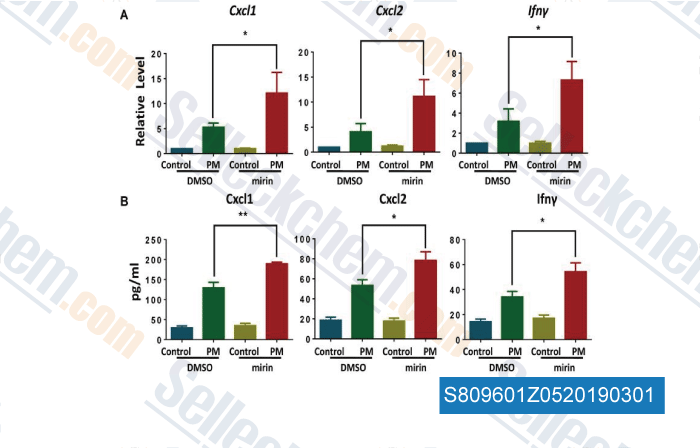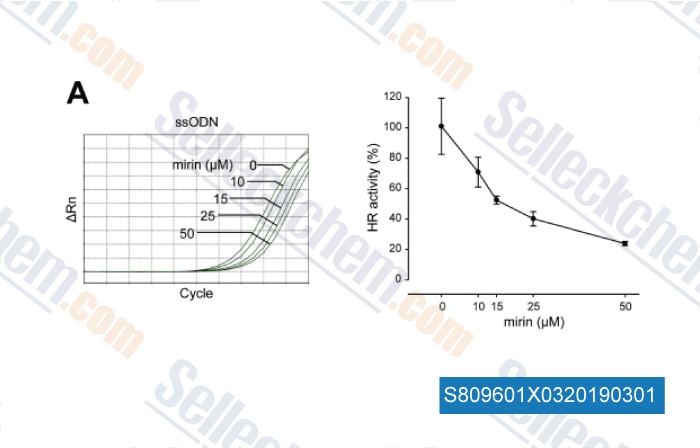|
Toll Free: (877) 796-6397 -- USA and Canada only -- |
Fax: +1-832-582-8590 Orders: +1-832-582-8158 |
Tech Support: +1-832-582-8158 Ext:3 Please provide your Order Number in the email. |
Technical Data
| Formula | C10H8N2O2S |
||||||
| Molecular Weight | 220.25 | CAS No. | 1198097-97-0 | ||||
| Solubility (25°C)* | In vitro | DMSO | 44 mg/mL (199.77 mM) | ||||
| Water | Insoluble | ||||||
| Ethanol | Insoluble | ||||||
| In vivo (Add solvents to the product individually and in order) |
|
||||||
|
* <1 mg/ml means slightly soluble or insoluble. * Please note that Selleck tests the solubility of all compounds in-house, and the actual solubility may differ slightly from published values. This is normal and is due to slight batch-to-batch variations. * Room temperature shipping (Stability testing shows this product can be shipped without any cooling measures.) |
|||||||
Preparing Stock Solutions
Biological Activity
| Description | Mirin is a potent Mre11–Rad50–Nbs1 (MRN) complex inhibitor, and inhibits Mre11-associated exonuclease activity. Mirin inhibits MRN-dependent activation of ATM. | ||
|---|---|---|---|
| Targets |
|
||
| In vitro | Mirin inhibits DSB-induced ATM activation, the ATM-dependent phosphorylation of the downstream targets Nbs1 and Chk2 and the MRN-dependent autophosphorylation of ATM at Ser1981 in response to DSBs. Mirin also inhibits the G2 checkpoint in TOSA4 cells, and homology-dependent DNA repair in HEK293 cells. [1] In cells with integrated HPV16 (SiHa), Mirin sensitizes HPV episomes to PA25 resulting in a ∼5-fold reduction of the PA25 IC50. [2] Pretreatment with mirin also decreases cell viability and inhibits proliferating cell nuclear antigen expression in cisplatin-treated human embryonic kidney 293 cells. [3] |
||
| In vivo | Mirin in nanoparticles resulted in a sharp impairment of tumor growth, associated with DDR activation, p53 accumulation, and cell death. |
Protocol (from reference)
| Kinase Assay: |
|
|---|---|
| Cell Assay: |
|
References
Customer Product Validation

-
Data from [ , , Aging, 2018, 10(4):549-560 ]

-
Data from [ , , DNA Repair, 2018, 70:67-71 ]
Selleck's Mirin has been cited by 37 publications
| Inherited deficiency of DIAPH1 identifies a DNA double strand break repair pathway regulated by γ-actin [ Nat Commun, 2025, 16(1):4491] | PubMed: 40368919 |
| Genome rearrangements induced by the stimulation of end-joining of DNA double strand breaks through multiple phosphorylation of MRE11 by the kinase PKB/AKT1 [ Nucleic Acids Res, 2025, 53(11)gkaf468] | PubMed: 40479710 |
| PARP10 promotes the repair of nascent strand DNA gaps through RAD18 mediated translesion synthesis [ Nat Commun, 2024, 15(1):6197] | PubMed: 39043663 |
| The MYCN oncoprotein is an RNA-binding accessory factor of the nuclear exosome targeting complex [ Mol Cell, 2024, S1097-2765(24)00285-5] | PubMed: 38703770 |
| Replication fork stalling in late S-phase elicits nascent strand degradation by DNA mismatch repair [ Nucleic Acids Res, 2024, gkae721] | PubMed: 39180395 |
| CAF-1 promotes efficient PrimPol recruitment to nascent DNA for single-stranded DNA gap formation [ Nucleic Acids Res, 2024, gkae1068] | PubMed: 39558157 |
| SNF2L suppresses nascent DNA gap formation to promote DNA synthesis [ Nucleic Acids Res, 2024, gkae903] | PubMed: 39413208 |
| Schlafen 11 further sensitizes BRCA-deficient cells to PARP inhibitors through single-strand DNA gap accumulation behind replication forks [ Oncogene, 2024, 43(32):2475-2489] | PubMed: 38961202 |
| RHOJ controls EMT-associated resistance to chemotherapy [ Nature, 2023, 616(7955):168-175] | PubMed: 36949199 |
| Replication fork uncoupling causes nascent strand degradation and fork reversal [ Nat Struct Mol Biol, 2023, 30(1):115-124] | PubMed: 36593312 |
RETURN POLICY
Selleck Chemical’s Unconditional Return Policy ensures a smooth online shopping experience for our customers. If you are in any way unsatisfied with your purchase, you may return any item(s) within 7 days of receiving it. In the event of product quality issues, either protocol related or product related problems, you may return any item(s) within 365 days from the original purchase date. Please follow the instructions below when returning products.
SHIPPING AND STORAGE
Selleck products are transported at room temperature. If you receive the product at room temperature, please rest assured, the Selleck Quality Inspection Department has conducted experiments to verify that the normal temperature placement of one month will not affect the biological activity of powder products. After collecting, please store the product according to the requirements described in the datasheet. Most Selleck products are stable under the recommended conditions.
NOT FOR HUMAN, VETERINARY DIAGNOSTIC OR THERAPEUTIC USE.
